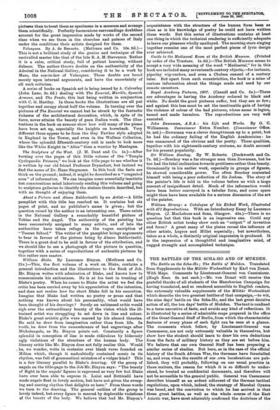William Blake. By Laurence Binyon. (Methuen and Co. 21s.)—This, the
first volume of a work on Blake, contains a general introduction and the illustrations to the Book of Job. Mr. Binyon writes with admiration of Blake, and knows how to communicate his enthusiasm. He is at his best in treating of Blake's poetry. When he comes to Blake the artist we feel the critic has been carried away by his appreciation of the intention, and does not realise how far short Blake fell in his execution. Imagine that Blake had written no poetry or prose and that nothing was known about his personality, what would have been thought of his drawings ? Surely an unbiassed critio would sigh over the extraordinary beauty of the vision which the ill. trained artist was struggling to set down in line and colour. Blake's groat artistic gifts were marred by his absurd theories. He said he drew from imagination rather than from life. In truth, he drew from the remembrance of bad engravings after Michelangelo, as Mr. Binyon points out. Constantly a figure splendid in conception of line is made ridiculous by hideously ugly violations of the structure of the human body. The . literary critic like Mr. Binyon does not fully realise this. Would
• he, we wonder, write in ecstasies over blank verso founded on Milton which, though it undoubtedly contained music in its rhythm, was full of grammatical mistakes of &vulgar kind ? This is a fair literary parallel to Blake's drawing. Of the group of angels on the title-page to the Job Mr. Binyon says "The beauty of flight in the angels' figures is expressed as very few but Blake have ever been able to express it. Lnini and Botticelli have made angels float in lovely motion, but have not given the sweep- ing and soaring rhythm that delights us here." From these words we turn to the drawing. The general outline of the group is lovely indeed, but every figure is marred by deplorable violations of the beauty of the body. We believe that had Mr. Binyon's acquaintance with the structure of the human form been as close as is his knowledge of poetry he could not have written these words. But this series of illustrations contains at least one thing in which the technical rendering is sufficiently adequate to leave our pleasure wholly unalloyed. The morning stars singing together remains one of the most perfect pieces of lyric design ever achieved.
















































 Previous page
Previous page